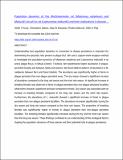| dc.contributor.author | Kessy, Stella | |
| dc.contributor.author | Sabuni, Christopher | |
| dc.contributor.author | Massawe, Apia | |
| dc.contributor.author | Makundi, Rhodes | |
| dc.contributor.author | Rija, Alfan | |
| dc.date.accessioned | 2024-05-23T12:55:37Z | |
| dc.date.available | 2024-05-23T12:55:37Z | |
| dc.date.issued | 2024-03-06 | |
| dc.identifier.uri | https://doi.org/10.1007/s10344-024-01773-8 | |
| dc.identifier.uri | https://dspace.nm-aist.ac.tz/handle/20.500.12479/2662 | |
| dc.description | This research article was pulished by Springer,In 2024 | en_US |
| dc.description.abstract | Understanding host population dynamics in connection to disease persistence is important for determining the epizootic risks present in plague foci. We used a capture-mark-recapture method to investigate the population dynamics of Mastomys natalensis and Lophuromys makundii in an active plague focus, in Mbulu District, Tanzania. We hypothesized higher abundance in plague-persistent locality and between habits and seasons. We found distinct patterns of abundance in M. natalensis between farm and forest habitats. The abundance was significantly higher in farms in plague persistent than non-plague persistent areas. The dry season showed a significant increase of abundance compared to the long rain season and the short rain season. A significant increase in breeding females was observed in farms in plague persistent than non-plague persistent localities while farms showed a significant decrease compared to forests. Dry season was associated with an increase in breeding females compared to the long rain season and the short rain season. Furthermore, the abundance of L. makundii showed a significant increase in forest in plague persistent than non-plague persistent localities. The abundance increased significantly during the dry season and long rain season compared to the short rain season. The proportion of breeding females was significantly higher in forests in plague persistent than non-plague persistent localities. The breeding females significantly increased during the dry and the short rain season than the long rain season. These findings contribute to our understanding of the ecological factors shaping the population dynamics of these species and their potential roles in plague persistence. | en_US |
| dc.language.iso | en | en_US |
| dc.publisher | Springer | en_US |
| dc.subject | Plague persistent | en_US |
| dc.subject | Rodent host | en_US |
| dc.subject | Population dynamic | en_US |
| dc.subject | Breeding pattern | en_US |
| dc.title | Population dynamics of the Multimammate rat (Mastomys natalensis) and Makundi’s brush fur rat (Lophuromys makundii) and their implications in disease … | en_US |
| dc.type | Article | en_US |

